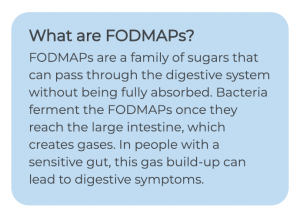Tomorrow is national pizza day! You may think you can only daydream about a slice while following a low-FODMAP diet, but you don’t have to miss out. With some tweaks, you can enjoy a low-FODMAP pizza at home.

First, the crust.
Pizza crust is typically made with all-purpose or bread flour. This contains inulin, which is a FODMAP that can lead to symptoms for some people. To avoid this, we suggest a gluten-free crust. Why gluten free? Gluten itself is not a FODMAP, but the type of
flours that contain gluten are also generally high in FODMAPs. So, using a gluten-free flour helps ensure you choose an option which also happens to be low FODMAP.
But if you’re making any gluten-free recipe, you still have to keep your eye out for other FODMAP sources. For instance, this is a great gluten-free pizza crust recipe you can try. However, you may want to substitute semi-skimmed milk for lactose-free milk to ensure you’re keeping your FODMAP sources to a minimum.
Second, the sauce!
Pizza sauce recipes can vary quite a bit, but many of them contain onion or garlic in some form. Both onion and garlic are yet another source of inulin! In large amounts, tomatoes can also have enough fructose to cause issues for some people who are sensitive to it. If you’re not sure how well you tolerate fructose, use a light hand when saucing your pizza to ensure you don’t overdo it.
Here’s a quick low-FODMAP pizza sauce recipe!
Prep time: 5 minutes
Ingredients
- 15oz (425g) can of diced tomatoes
- 6 oz (170g) of tomato paste
- ¼ teaspoon of dried oregano
- ½ teaspoon of salt
- ¼ teaspoon of black pepper
Instructions
- Drain your diced tomatoes to get rid of excess juice.
- Combine your diced tomatoes with tomato paste.
- Stir in oregano, salt and black pepper.
- Use an immersion blender to beat until smooth.
Finally, the toppings!
There is some good news here for you cheese fans! You may think the cheese topping your pizza is going to cause an issue, but most pizza is actually made with mozzarella, which is naturally low in lactose. If you would like to use a mixture of cheeses for extra flavour, check out this guide on how to select low-FODMAP cheeses.
When choosing your other toppings, remember that meat and poultry are naturally low in FODMAPs, but that processed meats like sausage can often contain things like garlic and onion. Some people with digestive issues find that high fat meals also aggravate their symptoms, so keep that in mind when adding toppings and deciding whether to have seconds!
If you’d like to keep it simple, add a little fresh basil, drizzle with garlic-infused oil and enjoy! The inulin in garlic isn’t oil soluble, so garlic-infused oil is a great way to get that flavour without the difficult to digest FODMAPs!
AIRE is a pocket-sized breath analysis device. It helps people with chronic digestive issues determine the foods that work best with their digestive system. To learn more about AIRE, visit www.foodmarble.com.
These recipes are low FODMAP to the best of our knowledge. However, FODMAP testing is an ongoing area, and can sometimes lead to changes in these recommendations.





